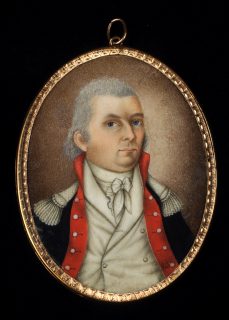
John Hutchinson Buell (1752-1813) was one of many officers who served in the Continental Army for the entire Revolutionary War. He was born in Hebron, Connecticut, on November 21, 1752. In the spring of 1775 he was appointed sergeant in James Clarke’s Company of Israel Putnam’s Regiment, which marched on Boston in response to the Lexington Alarm. He served with his regiment in the Siege of Boston. When the regiment was reorganized and taken into Continental service in early 1776, Buell was promoted to ensign of what was then known as Durkee’s Regiment.
In April 1776 the regiment marched to New Jersey, where it was stationed at Bergen Heights, Paulus Hook and Fort Lee, on the west side of the Hudson, during the defense of New York. Buell and his regiment retreated across New Jersey with Washington’s army and were subsequently engaged at Trenton and Princeton. Buell was promoted to second lieutenant in January 1777, to first lieutenant in November, and finally to captain on May 30, 1779. He participated in the battles of Brandywine, Germantown and Monmouth. In 1779 his regiment operated on the east side of the Hudson above New York, and spent the winter of 1779-1780 with the main body of the army at Morristown. The rest of his service is documented in his wartime diary, which, like this portrait miniature, is in the collections of the Society of the Cincinnati.
Buell returned to the army in 1791, securing a commission as a captain in one of the two newly constituted regiments destined for service on the western frontier. Like other captains, he was responsible for recruiting soldiers to fill out the ranks. Buell advertised for recruits in The Connecticut Courant and used his own home in Hebron as his recruiting station. He served with Arthur St. Clair’s army in the Northwest Territory, but was not present at St. Clair’s Defeat on November 1, 1791. On February 20, 1793, the Senate confirmed Buell’s appointment as a major in the United States Army. He served in that capacity, chiefly on the northwest frontier, until 1802—when he returned home for good.
This portrait miniature—painted in watercolor on ivory and encased in a rose gold locket with woven hair on the back—depicts Buell in the regimental uniform of a major in the United States Army. The miniature is unsigned, but it was probably the work of Isaac Sanford (1763-1824), a Connecticut-born portrait painter, engraver and silversmith. Working primarily in Hartford, Sanford made his living as a partner in several firms engraving plates for book illustrations, making clocks and watches, crafting silver and silver-plated wares, and painting portraits and miniatures. His painting style—evident in four other extant portrait miniatures and one engraved portrait—is more primitive than the styles of James and Charles Willson Peale and John Ramage. Sanford used very short brushstrokes, which are especially visible in faces and backgrounds, and strong lines defining the edges of elements in his compositions. His portraits emphasize strong facial features and billowing neck cloths. These characteristics are evident in the Buell miniature.
The major probably sat for this portrait on one of several return trips to Connecticut while on leave. He was home for a month after being promoted to major, and returned home between the spring of 1795 and mid-1796. These trips home are documented in a later diary. He may have made other visits for which documentation has not been found. Isaac Sanford remained in Hartford until mid-1799, when he left for nearly ten years of work in London. The hair in the back is undoubtedly Buell’s own hair and suggests that the miniature was a keepsake of Buell’s second wife, Sarah, whom he married in 1800.